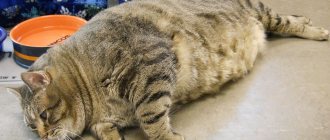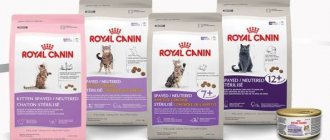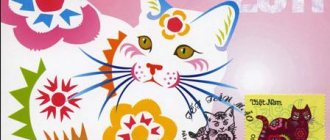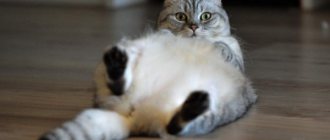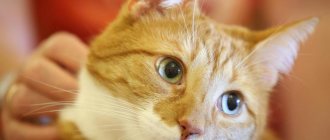Nutritional features of Persian cats
Persian cats should be given a balanced diet. Their daily menu should include foods rich in proteins, vitamins, fats and carbohydrates.
As you know, proteins in the animal’s body are broken down into amino acids. The latter, in turn, are extremely necessary in the construction of biological tissues, for example, bone and muscle, skin and claw plates. Therefore, protein products are indispensable in the diet of a Persian cat.
With an insufficient amount of arginine (it is not synthesized by the Persian body), serious problems begin with energy metabolism, metabolism, brain function and the gastrointestinal tract.
Taurine is also considered a necessary component for the cat's body. It helps maintain good functioning of the cardiovascular system, and also prevents eye diseases, to which Persians are so prone.
Carotene cannot be produced by the Persian cat's body, so the animal can only obtain this component necessary for health with vitamin complexes or industrial food.
Do not forget that Persians are prone to urolithiasis. Excessive amounts of mineral salts contribute to the appearance of conglomerates, so it is recommended to limit foods such as milk and fish in the diet of this breed.
In addition, the pet owner should follow the following rules:
- It is strictly forbidden to mix wet and dry ready-made food. The interval between meals of these two types of food should be at least 10-12 hours. If you do not heed this advice, your Persian may experience digestive disorders. Moreover, “individual” nutrition increases the load on the Persian’s liver.
- You should also not mix food from different manufacturers, for example, mousses and pates, or diets that take into account age and individual characteristics - dry food for kittens and sterilized cats, etc.
- There should be an interval between meals of homemade food and finished industrial products. It is worth waiting until it is completely digested.
- The share of wet food in the total volume of food for Persian cats should not exceed more than 25%.
Nutrition for illnesses
Let's talk about what food to feed a Persian cat that has health problems. Persians are genetically predisposed to diseases of the urinary system: urolithiasis, chronic renal failure, etc. Especially for such cases, leading manufacturers of cat products produce lines of medicinal food.
Medicinal brands for the Persian cat:
- Royal Canin Renal – chronic renal failure, prevention of relapse of urolithiasis;
- Pro Plan Veterinary Diets – kidney disease;
- Hill's “K/D” – maintaining kidney function;
- Beaphar "Nieren Ente" – kidney failure;
- Royal Canin Urinary Metal Feline – diseases of the urinary tract.
It is unacceptable to put your cat on a therapeutic diet on your own; it must be prescribed by a veterinarian.
Diet
Just like other pets, Persian cats should eat at approximately the same times. Although Persians are very gentle and vulnerable animals, they need to be taught discipline. The cat should have a single place for eating; it should not be taught to take tasty things from the hands of the owner.
The number and volume of servings directly depends on the age of the cat:
- up to one month – feeds on mother’s milk as needed;
- 1-2 months – up to 6 times a day;
- 2-4 months – the number of meals is reduced to 4-5 times;
- 4-6 months – the animal is transferred to three meals a day;
- from 10 months – can be switched to adult cat mode – 2 times a day.
The daily intake for a Persian baby is calculated according to the formula: 250 g per 1 kg of live weight. For an adult, this norm can increase by 100 g.
Why do Persians need special food?
This breed has a main feature – a flattened muzzle, which is why the animals have defects in the structure of the jaw. This usually manifests itself in the form of the following diseases:
- Tartar.
- Gingivitis.
- Stomatitis.
- Periodontal disease.
Also, cats of this breed are predisposed to diseases of the genitourinary system, which usually manifest themselves in adults. Separately, it is necessary to recall hypertrophic cardiomyopathy, which is also common in Persians.
| Brand | Manufacturer | Price |
| Royal Canin Persian | France | from 300 rub. |
| Guabi natural persa | Brazil | from 500 rub. |
| Farmina cimiao persian | Italy | from 450 rub. |
| Pureluxe elite nutrition | USA | from 500 rub. |
All these factors must be taken into account when choosing food, especially if your pet has hereditary cases of chronic gingivitis or stomatitis. In such cases, eating food of plant origin can lead to serious dental problems at an early age.
Natural food for a small Persian
In fact, up to two months of its life, the little press feeds exclusively on mother's milk. Then they gradually begin to introduce him to adult food, but there is no need to rush into this, because the baby’s gastrointestinal system is very delicate. Experts call the best period for the first complementary feeding 5-6 weeks of life.
To begin with, you can introduce the kitten to porridge. It should be boiled in milk diluted with water. In order for the baby to easily “cope” with such food, the porridge needs to be not hot (up to 37℃) and very liquid. Of course, you shouldn’t add salt or sweeten the dish.
At about the age of 3 months, it is recommended to start giving your baby frozen meat. Naturally, you first need to defrost it, pour boiling water over it and chop it as much as possible with a knife. A single dose of this product for a baby up to 4 months is 0.5 teaspoon. Vegetables should be introduced last, since the Persian kitten’s body does not immediately accept them well.
Starting from 5 months, you can introduce foods such as cottage cheese, yogurt, and quail eggs into the diet. It is also allowed to give pets a variety of meat, cereal, vegetable, and cottage cheese mixtures intended for children.
Dry food begins at six months. Until the kitten learns to chew it normally, it is recommended to pre-soak the granules in warm water or meat broth. Special premium wet food for kittens is also allowed from 4-6 weeks of age.
What care is needed
When you see a representative of this breed with a unique history and memorable appearance at exhibitions, you immediately want to have the same pet at home. But there is an opinion that there are many problems in caring for this animal, especially in the first months. What is the value of just one coat of wool! However, knowing about the basic intricacies of caring for a Persian kitten, you will understand that in fact you will not have anything difficult to do. We'll look at how to care for a pet with peach (and other) fur below.
Hygiene procedures
Since Persians have a characteristic muzzle structure, it is very difficult for them to take care of themselves on their own. That is why your key task is to carry out all hygiene procedures regularly and correctly. It is recommended to bathe your cat at least once a week. Pour some water into a basin or bathtub, but it is better not to use the sink for this purpose.
It is better to give preference to special store-bought shampoos designed for long-haired cats. The first stage of bathing is degreasing the coat. To do this, many people use the most common dishwashing detergent. Directly during the washing process, be sure to soap your cat's fur twice.
Try to pay special attention to the most contaminated areas (paws, tail and chin). Rinse off the soap mixture thoroughly. Otherwise, the hair will begin to stick together and tangle into lumps. After bathing, dry the cat's fur thoroughly and sprinkle it with special grooming powder. Use a hair dryer to dry.
Special attention should be paid to other hygiene procedures. It is recommended to brush your Persian's teeth monthly. Buy special chewing toys at pet stores: if the cat chews them often, yellow plaque will not appear on the teeth. It is also necessary to remove dirt from your pet's ears. Take some cotton swabs, soak them in Vaseline and then gently go over your kitty's ear.
It is also worth taking care of the cleanliness of your eyes. Use a paper towel or soft cloth to remove discharge every day. Do not use cotton wool, otherwise it will irritate the eyeball and it will water.
Combing and cutting hair
How to properly care for a Persian cat is a question that worries many owners of this breed. There are plenty of nuances to this process, so study the key recommendations thoroughly. Persian owners are accustomed to paying special attention to the most remarkable characteristic of the breed – the coat. You need to learn how to comb him. Do not forget that an adult Persian cat will not tolerate “invasion” of its territory. That is why it is advisable to accustom her to this procedure from an early age.
As soon as the kitten arrives in your home, brush its fur every day. It is best to do this before feeding your pet. In this case, he will develop a pleasant association with this procedure. Use a wire brush with fine teeth on one end and loose teeth on the other.
It is very important to do this procedure daily. And the reason is not only that the cat will look much better. If you don't regularly groom the coat, it will begin to mat and your pet's skin will become tight.
From time to time it is recommended to cut the cat's hair. In summer, it will be much easier to endure the heat. Yes, and you can take care of the coat without unnecessary difficulties.
To carry out such a procedure, it is better to contact a specialist. Some Persian owners prefer to handle the haircut themselves. But keep in mind: if you trim it incorrectly, bald spots may appear on your pet's skin.
What to feed an adult Persian cat
Just like most other cats, Persians need to eat meat frequently. In their daily diet, the meat part should be at least 50-60%. The share of vegetables in the total volume should not be more than 30%, and cereals - more than 10-18%. The following group of products is included in the daily menu for natural feeding:
- Meat . The most beneficial benefits come from lean boiled or chopped raw meat - chicken (dietary low-fat parts, for example, brisket), rabbit, beef, veal, lamb.
- Offal . Pieces of raw cow stomach will be the most useful. Persians also love chicken kidneys and hearts. You should avoid chicken necks or bone sets.
- Fish . This product is not paramount for the Persian breed. You can feed your four-legged friend fish no more than once every two weeks. It is better to give preference to marine and low-fat varieties. It is generally better to avoid river fish.
- Dairy and fermented milk products . Persians consume kefir with great pleasure. The optimal percentage of fat content is 1%. You can also give cottage cheese; if desired, your pet can dilute it with a small amount of water or yogurt. Low-fat yogurt can also be given. But it’s better to avoid cow’s milk altogether. In Persian cats it often causes diarrhea and bloating.
- Vegetables . It is recommended to add zucchini, cauliflower, carrots, pumpkin, green beans, and beets to meat dishes.
- Eggs . Not all cats, including Persians, can cope with digesting chicken eggs. However, they are a source of protein necessary for the body. Therefore, quail eggs would be the best option. They can be given to cats both raw and boiled.
- Cereals. The most suitable from this group are rice, barley and buckwheat.
It is recommended to approach the choice of each product as responsibly as possible. Persians should only eat freshly prepared food. Given their sensitive digestive system, you should not leave “for tomorrow” what was not eaten on time.
Nutrition for spayed and neutered Persians
As is known, sterile animals tend to gain excess weight due to decreased physical activity and increased appetite. Therefore, their diet should reduce the content of fat and carbohydrates, and add proteins, porridge with milk, and low-fat cottage cheese.
Careful monitoring of the amount of minerals in food, especially magnesium and phosphorus, is also necessary, as the likelihood of kidney stones increases. The stores also sell specialized food for sterilized cats and cats of different breeds.
Recipes for Persians
Persians love homemade cutlets. Of course, both in their composition and in the method of preparation, they differ significantly from those that people eat. The basis of the cat treat is dietary meat. It needs to be cut into pieces and boiled in clean water for approximately 10-17 minutes.
Separately, you need to boil any of the cereals (about 10-15 minutes). Both products must cool, and then it is recommended to mix them and form cutlets. The prepared semi-finished product must be stored in the refrigerator for 3 days. Before “serving” the cutlets need to be warmed up a little. The temperature of prepared dishes should not be more than 40℃.
You can also prepare your own wet food based on the type of production diet. To do this, you need to take 50% meat, 30% permitted vegetables and 20% cereals. Meat and cereal should be pre-cooked over a fire for 15-20 minutes. Vegetables can be added raw. Combine all components and mix. For greater benefit, you can add a small amount of olive or corn oil to this dish.
If a cat refuses to eat food, what should you do?
A cat may refuse to eat on several occasions. Sometimes a pet does not want to eat ready-made food when it is transferred to another manufacturer (even if it is premium food for a Persian). Lack of appetite can be caused by severe infection with worms, problems with the gastrointestinal tract, jaw injuries, toothaches, etc. In cases of complete refusal to eat for 3-4 days, you should urgently consult a veterinarian.
If your cat starts regurgitating pieces of fur, this is normal, especially for a long-haired Persian cat.
The best ready-made (industrial) rations
Ready-made industrial feeds from leading manufacturers help satisfy all the gastronomic needs of the Persians, as well as provide their bodies with useful microelements and vitamins. After analyzing the products available on the market, experienced veterinarians and breeders have compiled a list of the best foods for the Persian cat breed:
- Golden Eagle Holistic Adult Cat . Natural food from an American manufacturer. It contains approximately 32% of the protein Persians need. This product was a joint development of nutritionists, geneticists and veterinarians. Can be used by cats during pregnancy and feeding.
- Orijen Cat 6 Fresh Fish . Canadian granular product, characterized by a strong and pleasant smell for the animal. It contains different types of fish and a vitamin complex.
- Royal Canin Persian . A very appetizing French product created specifically for the Persian breed. It contains chicken meat, vegetables and grains. Prevents diseases of the digestive tract and ensures the beauty of the coat.
- Purina Pro Plan Delicate . Developed by Italian specialists specifically for those cats that have problems with the digestive system. More than 40% of the feed is protein. Also contains a vitamin complex.
- Bosch Sanabelle Hair. Offer from a manufacturer from Germany. The formula of this ready-made dish is designed specifically for long-haired cats. It has a positive effect on the digestive system and is made from poultry meat, rice and vegetables.
The ideal, according to many experts, would be industrial feed consisting of:
- pure meat – by 30-35%;
- plant fibers – up to 20%;
- protein natural filler – approximately 20%;
- offal or bone meal – up to 10%;
- natural oils;
- vitamin and mineral complexes.
If the owner decides to feed the cat commercial food (especially dry food), it is recommended to ensure that he drinks plenty of clean water.
Where can you buy inexpensive dry food for your Persian cat?
In the Zooset online store you can buy the best dry food for Persian kittens and adult cats in different price categories. We select only high-quality and fresh diets for pets of different breeds.
Here you can order the best premium food for Persian kittens and adult cats from such popular brands as Beaphar, 1st Choice, Gina, Grandorf, Royal Canin, Eukanuba, Happy Cat, Hill’s
, Monge, Pronature, Purina and others. We also recommend that you buy canned food for cats TM Hill's, Schesir, Mi-Mi, Eminent, Farmina, RC, Edel Cat, GINA, Gourmet, Pro Plan, Dr. Clauders, Night Hunter, Our Brand, Mon Ami. For Persians, it is better to choose food for long-haired cats - such diets include components that stimulate the removal of hair from their gastrointestinal tract.
Reasons to buy holistic food for Persian cats in the Zooset online store:
- A wide variety of high-quality healthy food in different price categories.
- Affordable prices for Persian cat food and other pet supplies.
- Guaranteed high quality of all products presented.
- Possibility to place an order in just a few minutes.
- Fast delivery in St. Petersburg, regions of Russia and Leningrad Region.
Interesting on the topic:
What is forbidden to feed a Maine Coon The best food for Sphynxes What food to choose for Siamese cats Daily feeding requirements for British cats
Analysis:
| Nutrients | |
| Squirrels | 30.0% |
| Fats | 22.0% |
| Humidity | 5.5% |
| Starch | 24.7% |
| Minerals | 6.5% |
| Total fiber | 5.0% |
| Alimentary fiber | 11.3% |
| DL-methionine | 0.92% |
| Methionine + cystine | 1.4% |
| Linoleic acid | 4.69% |
| Arachidonic acid | 0.1% |
| Omega-3 fatty acids | 1.06% |
| Omega-6 fatty acids | 4.96% |
| Acids EPA + DHA | 0.4% |
| Taurine | 0,3% |
| L-carnitine | 50.0 mg/kg |
| Lutein | 5.1 mg/kg |
| Nitrogen-free extractives | 31.0% |
| Minerals | |
| Calcium | 0.8% |
| Phosphorus | 0.72% |
| Copper | 15.0 mg/kg |
| Iron | 187.0 mg/kg |
| Magnesium | 0.05% |
| Manganese | 65.0 mg/kg |
| Potassium | 0.7% |
| Selenium | 0.27 mg/kg |
| Sodium | 0.5% |
| Chlorides | 0.93% |
| Zinc | 194.0 mg/kg |
| Iodine | 4.6 mg/kg |
| Vitamins | |
| Kholin | 2500.0 mg/kg |
| Folic acid | 12.9 mg/kg |
| Biotin | 2.92 mg/kg |
| Vitamin A | 30,000.0 IU/kg |
| Vitamin C | 300.0 mg/kg |
| Vitamin E | 600.0 mg/kg |
| Vitamin B1 (Thiamin) | 25.7 mg/kg |
| Vitamin B2 (Riboflavin) | 46.2 mg/kg |
| Vitamin B3 (Niacin) | 458.7 mg/kg |
| Vitamin B5 (Pantothenate) | 137.9 mg/kg |
| Vitamin B6 (Pyridoxine) | 72.0 mg/kg |
| Vitamin B12 (Cyanocobalamin) | 0.13 mg/kg |
| Vitamin D3 | 800.0 IU/kg |
Features of proper feeding of cats and kittens of the Persian breed
What is the right way to feed Persians? Most Persians are not picky eaters. But when deciding what to feed a Persian cat, their owners should remember that the digestive system of these cats is delicate and has its own physiological characteristics. There are two basic rules that owners of Persian cats must strictly follow. They cannot be fed:
- Mixing natural and industrial feeds.
- Mixing food from different manufacturers.
If you feed your Persian with wet canned and dry food, then the time interval between “drying” and canned food should not be less than 10 hours, and the percentage of wet food should not exceed the daily 25% of the volume eaten.
What to feed an adult and healthy Persian
Of course, the question of what to feed a Persian cat is individual and largely depends on the financial and time capabilities of the owners. But if a decision is made in favor of natural food for your pet, you should remember that Persians are not allowed to:
- nothing hot, spicy, salty or peppery;
- dairy;
- containing potato or corn starch;
- sausage (any kind), frankfurters, boiled pork and ham;
- eggplants (they are literally poisonous to cats of any breed and mongrel);
- any bones;
- any fish (since Persians are prone to cystitis, as well as other diseases of the genitourinary system; with urolithiasis, for example, fish literally provokes exacerbations);
- chicken heads, paws and even offal;
- liver - both raw and boiled.
In search of an answer to the question of what to feed a Persian cat, many choose “natural food” as the only option for the Persian’s health. And this is true in some cases. You just need to remember that natural food should be fortified and mineralized with appropriate additives, after consulting with a veterinarian about dosages. And “natural food” should always be freshly prepared. And no food “from the master’s table”!
Many owners, when deciding for themselves what to feed their Persian, choose industrial feed, saving their own time. And this is right, because manufacturers of premium and super-premium food for Persian cats make perfectly balanced food containing all the elements and substances necessary for Persian health.
What to feed a Persian kitten
The Persian cat needs to be fed properly from childhood. And of course, the owners of these purebred animals are interested in what to feed the Persian kitten so that it grows up beautiful and healthy. Experts (veterinarians and breeders of Persian cats) are confident that the health of pets directly depends on the quality and fundamental composition of their food. A cat is not a person, its stomach is very delicate! In addition, Persians are also predators; they cannot be left without animal proteins. But their teeth - due to the structural features of the muzzle - are very small with the exception of the fangs, so natural food will have to be crushed, and industrial food will have to be bought with specially shaped granules. So what exactly should you feed your Persian kitten? In different periods of life - in different ways. Moreover, the food of a two-month-old kitten, for example, should differ from the diet of a three-month-old baby, and even more so, a six-month-old baby. Both in quantity and in rational diversity.
What to feed a sterilized Persian cat
A separate topic is what to feed a sterilized Persian cat. Because these animals are already characterized by increased body weight, and when castrated or sterilized they begin to gain even more weight. And if you take into account the melancholic nature of the Persians and, as a result, their completely inactive lifestyle, it becomes clear why many of them suffer from obesity and related diseases - diabetes mellitus, hepatic focal lipidosis, inflammation of the pancreas, etc. That is why the problem of what to feed a sterilized Persian cat is not an idle curiosity of the owners of these truly luxurious animals. And frankly speaking, it is very difficult to provide complete natural nutrition for spayed and neutered Persian cats at home. The diet of such pets must include meat (exclusively beef), fermented milk products, fresh vegetables (except potatoes and carrots, since Persians do not absorb carotene and cannot tolerate starchy substances).
An excellent option for natural feeding of Persians is meat cutlets with the addition of vegetables and cereals. To prepare minced meat for this dish, you need to take finely chopped beef and boil it in water - bring to a boil and cook for at least a quarter of an hour. Then add the diced zucchini and beets, and after another 15 minutes, reduce the heat and add a mixture of cereals - rice, barley and wheat chaff. Cook everything for another 5 minutes, then remove from heat and puree in a blender. Then make small cutlets from the resulting minced meat and give them to the cat.
The food of a sterilized Persian beauty (or a neutered handsome man) should be at room temperature and always fresh. The cutlets described above can be stored in a closed saucepan in the refrigerator, but no more than 3 days. Persians can be given low-fat cottage cheese, natural sugar-free yoghurts and raw quail eggs (but no more than 3 pieces per week). But it’s better to avoid boiled chicken eggs.
What Persians can't do
Just like some other cat breeds, Persian cats cannot eat certain foods that are very familiar to people, but harmful to animals. It is strictly forbidden to feed Persians the following foods:
- fatty meats, especially pork, lamb, fatty parts of poultry – take a long time to digest and make it difficult for the liver;
- boiled-smoked products - sausages, sausages, smoked hams, etc.;
- eggplants contain substances that are toxic to animals;
- any spices and additives, including salt, mayonnaise, ketchup;
- tubular bones - can cause injuries to the digestive tract, get stuck in the throat or completely block the intestinal patency;
- onions and garlic - irritate the mucous membranes and cause fermentation;
- liver, boiled or raw;
- fatty sour cream and cream - cause digestive problems;
- sweets are also poisonous to animals.
It is also recommended to limit the amount of dairy products. Abuse of them can cause indigestion and bloating. Although fish is a tasty delicacy for animals, in excessive quantities it can harm the animal’s kidneys. To prevent possible complications, its use is limited to twice a week.
If the owner takes care of a healthy and balanced diet for the Persian cat, he will be able to enjoy his friendly company for many years. The thick and lush fur of representatives of the breed will please the eye only if the cat’s body has enough minerals and essential vitamins.
How and what to feed Persian cats correctly? These beauties are the most beautiful of the domestic cat family. These are magnificent animals with an absolutely individual, memorable and easily recognizable appearance. The most successful attempt by a person to create an “eternal kitten” with a sweet short face and an unusually easy-going disposition. The Persian lifestyle is leisurely and measured. These cats sleep 18-20 hours a day. And it seems that they - melancholic by nature - are not interested in anything in the world! But this is far from true. In fact, they are closely observing everything that is happening through the barely opened eyelids of bottomless round Persian eyes.
Persian haircut
Persians, like cats of other domestic breeds, have many owners trim their claws. This is done in order to protect not only the expensive wallpaper on the walls and upholstered furniture, but also the skin of the owners’ hands and feet. For this procedure, you must have a cat nail clipper. The claw must be trimmed skillfully so as not to injure the blood vessel passing inside it.
Grooming of Persian cats for exhibition is carried out in a professional salon by a groomer. Before visiting the salon, the cat should be washed and combed. In addition to decorative haircuts, Persian cats are also given hygienic haircuts.
How should you bathe an extreme type Persian cat?
It is recommended that two people wash an extreme type Persian cat. Before bathing, you need to comb the animal, plug the ears with cotton wool and drop drops into the eyes in case shampoo gets into them. All supplies must be prepared in advance so as not to delay the procedure. It is advisable to spread a towel or something similar at the bottom of the bathing container so that the Persian's paws do not slip. Before soaping, you should degrease the wool with dishwashing detergent. Then lather the extremal with cat shampoo several times and rinse.
The last rinse must be very thorough so that subsequently the shampoo not washed off does not lead to the formation of tangles. After this, dry the coat well with a towel and hair dryer. During drying, the coat must be combed immediately with a wire brush. When the coat is barely damp, it is recommended to treat it with grooming powder.
How to care for the fur of an extreme type Persian cat?
The fur of extreme type Persian cats requires careful care. Fine hairs constantly fall off and if the tangles are very neglected, they can only be cut off with scissors, so regular hair care is the key to the beauty of your pet. The coat needs to be brushed 2-5 times a week.
Owners will have to determine the frequency of procedures independently, based on the individual characteristics of the Persian. To comb extreme people, they usually use a sparse comb (preferably with rotating teeth) and a massage brush (metal with an antistatic coating and safe teeth). It is not recommended to use a slicker, as the undercoat hair of Persians is easily pulled out, but is difficult to restore. It is undesirable to comb the tail for a similar reason. Excessive zeal in combing will deprive the cat of such an advantage as fluffiness. It is recommended to finish tidying the coat by spraying a conditioner spray, and use a protein spray about once a week.
What to feed your Persian at different stages of his life?
What to feed a Persian at different stages of its life is what worries the owners of Persian cats. Pets need to be taught proper nutrition from early childhood. As soon as they appear in the house. You need to correctly assess your own capabilities, consult with a veterinarian and the breeder from whom the animal was purchased. And feed it so that as the kitten grows up it acquires a truly luxurious coat, strong claws and teeth, without experiencing problems with digestion and health in general.
What to feed a Persian kitten for 2 months
Until two months of age, almost all Persian kittens are fed breast milk. But what to feed a Persian kitten at 2 months? In fact, everything is not as difficult as it might seem. During this period, the kitten should begin to be fed. And for complementary feeding, of course, you need to take only the freshest products, keeping in mind the delicate Persian stomach.
At this age, a baby Persian cat should eat at least 6 times a day. And he needs to be given porridge boiled in low-fat milk and half and half water. No salt sugar! Plus scalded frozen lean meat scraped off with a knife. You can give vegetable purees - freshly cooked and chopped or from baby food jars. Just a little bit - literally one finger at a time.
What to feed a Persian kitten at six months
What to feed Persian kittens at six months? First of all, you need to increase the portions. And the meat can not only be scraped and scalded, but also boiled. The main thing is that it is not greasy. You also need to reduce the number of feedings to 3-4 per day. And if you decide that your furry treasure will eat dry food, then it’s time to introduce him to it. And first, just soak the granules in chicken or beef broth. But milk and dairy products (except for low-fat cottage cheese) should disappear forever from the cat’s diet. But cream and sour cream should not appear there. But eggs may appear - those same quail ones. You can leave fermented unsweetened yoghurts. And there must be water. Plenty and freely available. Always fresh.
What to feed a Persian up to a year old
From 6 months to a year, the diet of a Persian kitten practically does not change. The weight of single servings only increases and the number of feedings decreases (to 2-3 per day). By the age of one year, a male cat of the Persian breed should be completely switched to an “adult” diet. If it is dry food, then only it is “premium class”, professional, from a well-known manufacturer. If it's canned, then canned. And if according to the formula “canned food + drying”, then the first is no more than 25% of the total diet. And one manufacturer.



